- Why Grow Pomegranate at Home?
- Health Benefits of Pomegranate
- 1. Rich in antioxidants
- 2. Boosts immune system
- 3. Heart-healthy
- 4. Anti-inflammatory properties
- 5. Supports digestion
- 6. May improve memory
- 7. Anti-aging benefits
- 8. Cancer-fighting properties
- Choosing the Right Variety
- Table: Comparison of Pomegranate Varieties
- Climate and Soil Requirements
- Climate
- Soil
- Planting Pomegranate Trees
- Watering and Fertilizing
- Watering
- Fertilizing
- Pruning and Training Techniques
- 1. Pruning
- 2. Training
- 3. Rejuvenation Pruning
- Harvesting and Storing Pomegranates
- Harvesting Pomegranates
- Storing Pomegranates
- Tips for Handling Pomegranates
- Troubleshooting Common Pomegranate Problems
- 1. Lack of Fruit Production
- 2. Pest Infestation
- 3. Diseases
- 4. Yellowing Leaves
- 5. Splitting Fruit
- Q&A:
- What is the best time to plant a pomegranate tree?
- Can I grow a pomegranate tree indoors?
- How often should I water my pomegranate tree?
- What type of soil is best for growing pomegranate trees?
- How long does it take for a pomegranate tree to bear fruit?
- What are some common pests and diseases that affect pomegranate trees?
- Video: How To Grow & Prune A Pomegranate Tree | Complete Step By Step Guide
Growing pomegranate at home can be a rewarding experience for any beginner gardener. Pomegranate trees not only produce delicious fruit, but they also add beauty and vibrancy to your garden with their striking red flowers and glossy green leaves. Whether you have a large backyard or a small balcony, you can successfully grow pomegranate trees with a little bit of care and attention.
Choosing the Right Variety: Before starting your pomegranate growing journey, it’s important to choose the right variety that suits your location and climate. Some popular varieties for home cultivation include ‘Wonderful’, ‘Angel Red’, and ‘Ambrosia’. Consider factors such as the average temperature and the number of chilling hours required for proper fruit set when selecting your pomegranate variety.
Providing Adequate Sunlight: Pomegranate trees thrive in full sunlight, so make sure to choose a sunny spot in your garden for planting. At least 6 to 8 hours of direct sunlight per day is ideal for healthy growth and fruit production. If you don’t have enough sunlight in your yard, you can consider growing pomegranate trees in containers and placing them in a sunny location, such as a rooftop or balcony.
Preparing the Soil:
Pomegranate trees prefer well-draining soil with a pH level ranging from 5.5 to 7.5. Before planting, amend the soil with organic matter such as compost or well-rotted manure to improve drainage and provide essential nutrients. Avoid heavy clay or waterlogged soils, as they can lead to root rot and other diseases. If necessary, you can also raise the planting area by creating a raised bed or mound to ensure proper drainage.
Why Grow Pomegranate at Home?
Pomegranates are not only delicious fruits but also beautiful ornamental plants. Growing pomegranates at home can offer a range of benefits:
- Tasty and Nutritious Fruits: Pomegranates are known for their sweet and tangy flavor. They are also rich in antioxidants, vitamins, and minerals, making them a healthy addition to your diet.
- Cost Savings: Buying fresh pomegranates from the store can be expensive. Growing them at home allows you to enjoy an abundant supply of fresh fruits without breaking the bank.
- Satisfaction and Pride: Watching your pomegranate tree grow, flower, and produce fruits can bring a sense of fulfillment. It can also be a source of pride knowing that you cultivated it yourself.
- Aesthetic Appeal: Pomegranate trees have beautiful flowers and attractive foliage, making them a great addition to any garden. Their vibrant colors can enhance the visual appeal of your outdoor space.
- Environmental Benefits: Pomegranate trees are known for their ability to adapt to diverse climatic conditions. By growing them at home, you contribute to the preservation of these amazing plants and help promote biodiversity.
Overall, growing pomegranates at home can provide you with a rewarding experience, a fresh supply of delicious fruits, and a beautiful addition to your garden. It’s a win-win situation for both your taste buds and your environment!
Health Benefits of Pomegranate
Pomegranates are delicious fruits that not only taste great but also offer a wide range of health benefits. Here are some of the reasons why you should consider adding pomegranates to your diet:
1. Rich in antioxidants
Pomegranates are packed with antioxidants, which help protect the body against free radicals that can cause damage to cells. Antioxidants also play a key role in reducing inflammation and preventing chronic diseases such as heart disease and cancer.
2. Boosts immune system
Pomegranates are an excellent source of vitamin C, which is known to boost the immune system. A strong immune system helps protect the body from infections and illnesses by fighting off harmful pathogens.
3. Heart-healthy
Consuming pomegranate regularly can help improve heart health. The fruit is known to reduce cholesterol levels, lower blood pressure, and prevent the formation of plaque in the arteries, reducing the risk of heart disease.
4. Anti-inflammatory properties
Pomegranates contain powerful anti-inflammatory compounds such as punicalagins and punicic acid, which can help reduce inflammation in the body. Chronic inflammation is linked to various diseases, including arthritis and certain types of cancer.
5. Supports digestion
Pomegranates are a good source of dietary fiber, which is essential for healthy digestion. Consuming fiber-rich foods like pomegranate can promote regular bowel movements and prevent constipation.
6. May improve memory
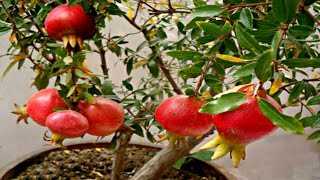
Studies suggest that pomegranates may have a positive impact on memory and cognitive function. The antioxidants found in the fruit help protect the brain from oxidative stress and may improve memory and learning abilities.
7. Anti-aging benefits
Due to its high antioxidant content, pomegranate can help slow down the aging process by protecting the skin from damage caused by free radicals. It may also promote collagen production, improving skin elasticity and reducing wrinkles.
8. Cancer-fighting properties

Some studies have shown that the antioxidants and other compounds found in pomegranate may have anticancer properties. They may inhibit the growth of cancer cells and prevent the spread of tumors, particularly in breast and prostate cancer.
| Nutrient | Amount per 100g |
|---|---|
| Calories | 83 |
| Carbohydrates | 18.7g |
| Fiber | 4g |
| Protein | 1.7g |
| Fat | 1.2g |
| Vitamin C | 10.2mg |
| Potassium | 236mg |
| Vitamin K | 16.4mcg |
These are just a few of the many health benefits that pomegranates have to offer. So why not incorporate this nutritious fruit into your diet and enjoy its many advantages?
Choosing the Right Variety
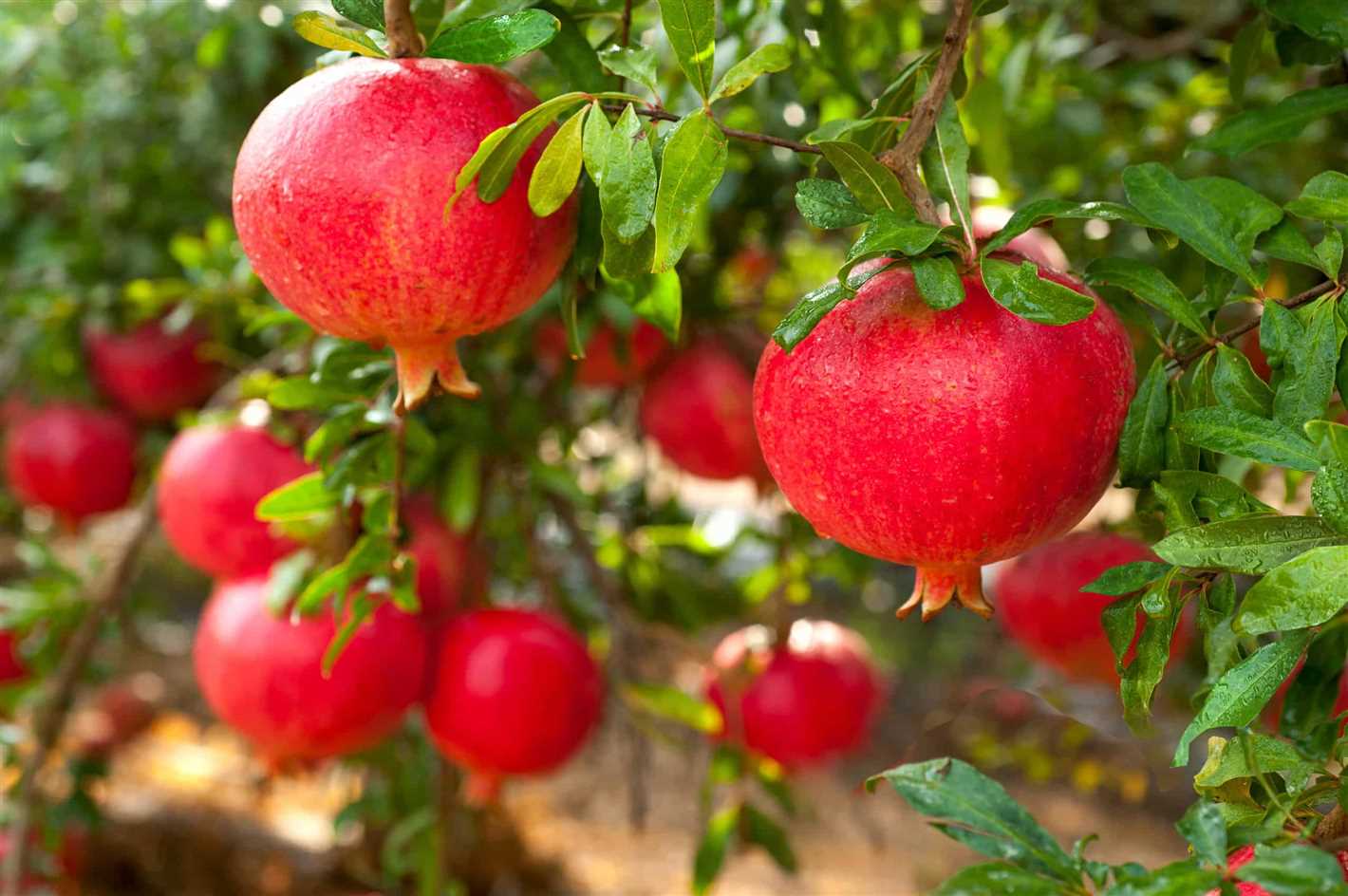
When it comes to growing pomegranates at home, choosing the right variety is crucial. Different varieties have different characteristics, such as size, flavor, and hardiness. Here are some popular pomegranate varieties that are suitable for home gardening:
- Wonderful: This is one of the most widely cultivated varieties. It produces large and sweet fruits with a deep red color.
- Grenada: Grenada is known for its juicy and flavorful fruits. The skin color can range from light pink to deep red.
- My Wonderful: This variety is a dwarf version of the Wonderful pomegranate. It is perfect for container gardening or small spaces.
When choosing a pomegranate variety, consider the climate and growing conditions in your area. Some varieties are more cold-hardy, while others prefer warmer climates. Additionally, consider the space available in your garden or the size of the container if you are planning to grow pomegranates in pots.
It is also worth noting that pomegranate trees are self-pollinating, but planting multiple varieties can improve fruit set and yield. Cross-pollination between different varieties can increase genetic diversity and lead to better fruits.
Table: Comparison of Pomegranate Varieties
| Variety | Fruit Size | Flavor | Hardiness |
|---|---|---|---|
| Wonderful | Large | Sweet | Hardy |
| Grenada | Medium to large | Juicy and flavorful | Moderate |
| My Wonderful | Medium | Sweet | Hardy |
Keep in mind that these are just a few examples, and there are many other pomegranate varieties available. Research different varieties and consult with local gardening experts to find the best variety for your specific growing conditions.
Climate and Soil Requirements
When it comes to growing pomegranates at home, it is essential to choose the right climate and provide the appropriate soil conditions for the plants to thrive. Pomegranates are native to regions with a Mediterranean climate, characterized by hot, dry summers and mild, wet winters. However, they can also be grown in other climates as long as certain conditions are met.
Climate
Pomegranates generally prefer a sunny and warm climate, with temperatures ranging from 40°F (4°C) to 90°F (32°C). They can tolerate some cold weather, but prolonged exposure to temperatures below 20°F (-6°C) can damage the plants.
In areas with colder climates, it may be necessary to grow pomegranates in containers so that they can be brought indoors during winter or protected with frost covers. If your region experiences long and freezing winters, it may not be suitable for growing pomegranates outdoors.
Soil
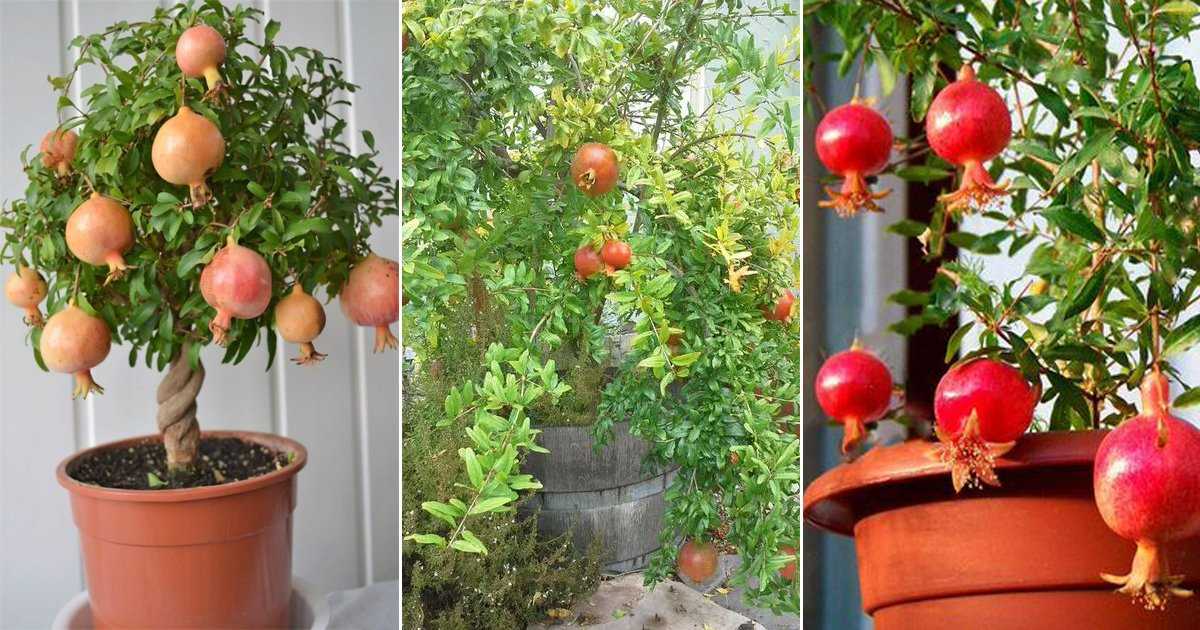
Pomegranates thrive in well-drained soil with a pH level between 5.5 and 7.5. They are adaptable to various soil types, including loam, sandy loam, and clay loam. However, it is essential to avoid soils that are too heavy or waterlogged, as they can cause root rot and other problems.
Prior to planting, it is recommended to prepare the soil by adding organic matter, such as compost or well-rotted manure, to improve its fertility and drainage. This will help create a favorable environment for the pomegranate plants to establish and grow.
It is also important to note that pomegranates are relatively drought-tolerant once established. However, to promote healthy growth and fruit production, regular watering is still necessary, especially during dry periods or when the plants are young.
Planting Pomegranate Trees
When it comes to planting pomegranate trees, it is important to choose the right location and prepare the soil properly. Here are the steps you need to follow:
- Choose a Suitable Location: Pomegranate trees require full sun, so select a spot in your garden that receives at least 6-8 hours of direct sunlight per day.
- Prepare the Soil: Pomegranate trees prefer well-drained soil with a pH level between 5.5 and 7.5. Make sure the soil is fertile and rich in organic matter. If necessary, amend the soil with compost or aged manure to improve its quality.
- Planting: Dig a hole that is twice as wide and deep as the root ball. Place the tree in the center of the hole and backfill it with soil, gently firming it around the roots. Make sure the tree is planted at the same depth as it was in the nursery container.
- Spacing: Pomegranate trees need enough space to grow and spread their branches. Space multiple trees at least 15-20 feet apart to ensure proper air circulation and sunlight exposure.
- Watering: After planting, water the tree thoroughly to settle the soil and eliminate any air pockets. Keep the soil consistently moist but not waterlogged. During the first year, water the tree deeply once or twice a week.
- Mulching: Apply a layer of organic mulch around the base of the tree to help conserve moisture, suppress weeds, and maintain a more stable soil temperature.
- Pruning: Prune your pomegranate tree in late winter or early spring to remove any dead or damaged branches and maintain a balanced shape. Remove any suckers or low-growing branches to promote upward growth.
- Fertilizing: Apply a balanced slow-release fertilizer in early spring and again in late summer to provide essential nutrients to your pomegranate tree.
- Protection: Protect your pomegranate tree from extreme temperatures, especially during winter. Consider covering the tree with a frost cloth or moving it to a more sheltered location if necessary.
By following these steps, you can successfully plant and grow pomegranate trees in your own backyard. With proper care and maintenance, you will soon be able to enjoy the tasty and nutritious fruits they produce.
Watering and Fertilizing
Proper watering and fertilizing are crucial for the healthy growth and development of pomegranate plants. Here are some important guidelines to follow:
Watering
Pomegranate trees have deep roots, so it’s important to provide deep watering rather than frequent shallow watering. This helps the roots establish and reach deep into the soil, making the plants more resilient to drought.
During the first year after planting, water the pomegranate plants every 5-7 days, providing 15-20 gallons of water per week. In subsequent years, water the plants deeply every 10-14 days, increasing the amount of water to 20-30 gallons per week. However, adjust the watering schedule based on local weather conditions and the moisture level of the soil.
It’s important to avoid overwatering, as excessive moisture can lead to root rot and other fungal diseases. Make sure the soil has good drainage to prevent waterlogging.
Fertilizing
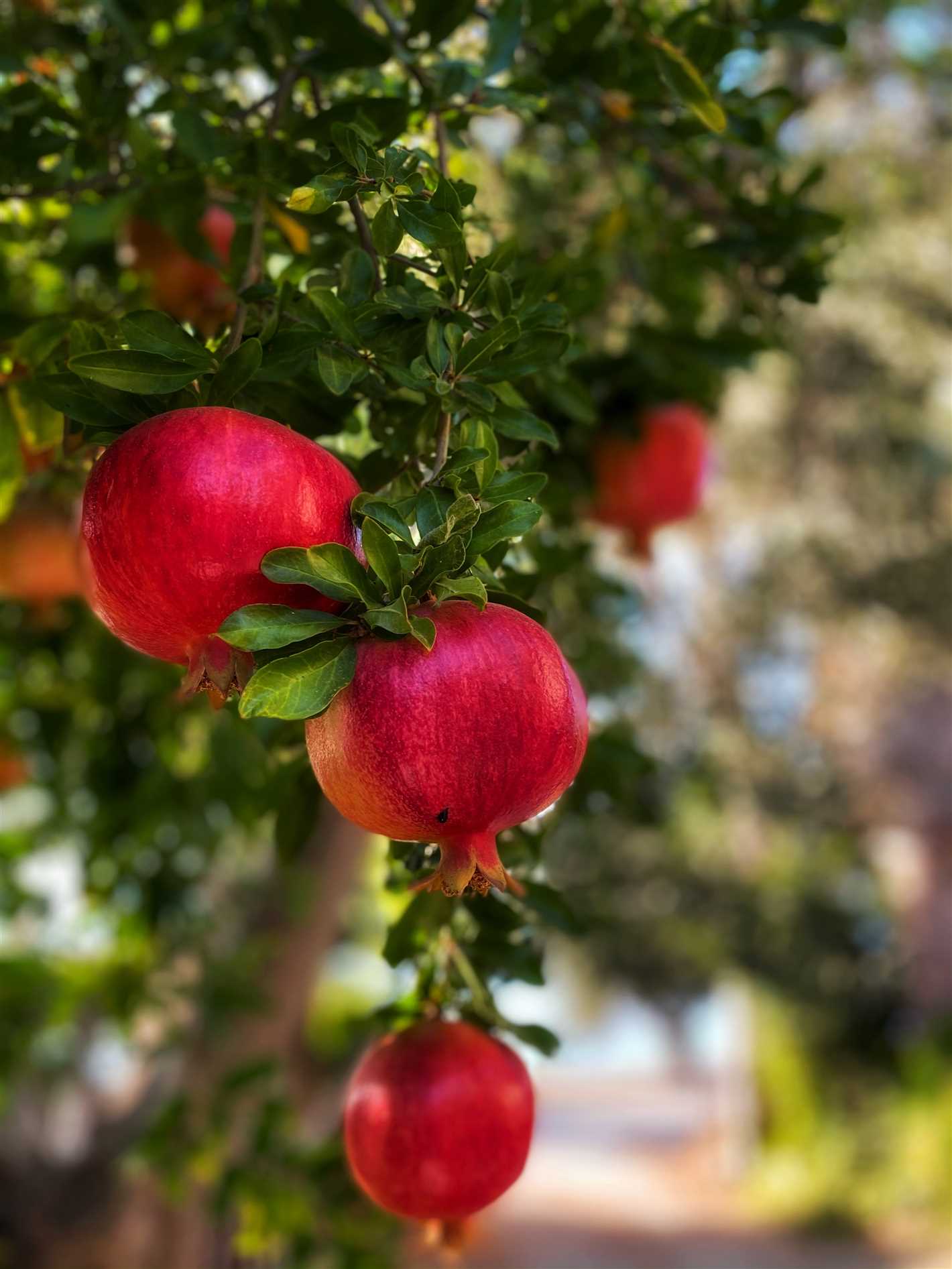
Pomegranate plants benefit from balanced fertilizers that provide essential nutrients. Here are some fertilizing guidelines:
- Apply a balanced fertilizer, such as 10-10-10, in early spring before new growth begins. Follow the manufacturer’s instructions for the application rate.
- During the first year, apply fertilizer every 6-8 weeks. In subsequent years, apply fertilizer every 8-12 weeks.
- Do not fertilize pomegranate plants after mid-summer, as late-season growth may not have time to harden off before winter.
- Avoid excessive use of nitrogen fertilizer, which can promote vegetative growth at the expense of fruit production.
- Organic fertilizers, such as compost or well-rotted manure, can also be used to provide nutrients to pomegranate plants. Apply them in early spring.
Regularly monitor the plants for nutrient deficiencies, such as yellowing leaves or slow growth. Adjust the fertilization schedule and nutrient composition accordingly. It’s also a good idea to have the soil tested periodically to determine any specific nutrient requirements.
Pruning and Training Techniques
Proper pruning and training techniques are essential for the healthy growth and productivity of your pomegranate tree. Here are some guidelines to follow:
1. Pruning
Pruning helps promote airflow and light penetration, leading to healthier plants and better fruit production. Follow these steps for proper pruning:
- Start pruning in late winter or early spring before new growth begins.
- Remove any dead, damaged, or diseased branches using sanitized pruning shears.
- Thin out crowded branches to improve airflow and light penetration.
- Trim back long, leggy branches to encourage bushier growth.
- Aim to maintain an open, vase-shaped structure for the tree.
2. Training
Training your pomegranate tree involves shaping it when it’s young to develop a strong structure and focus growth in the desired direction. Here’s how you can train your pomegranate tree:
- Choose a central leader, which will be the main trunk of the tree.
- Remove any competing branches or side shoots that may become dominant.
- Prune the central leader to about 24 inches in height during the first year.
- Encourage lateral branches to grow by pruning to an outward-facing bud.
- In subsequent years, prune to maintain the desired height and shape of the tree.
3. Rejuvenation Pruning
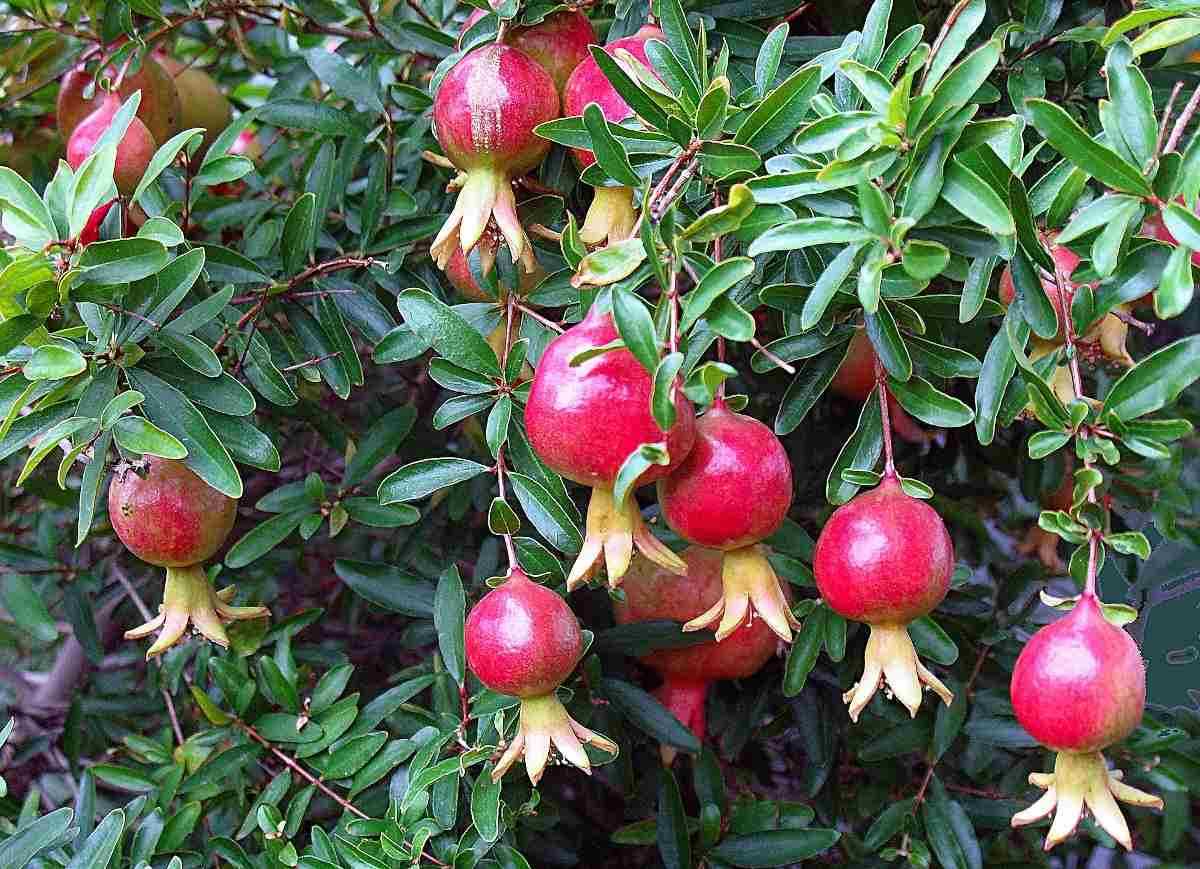
If your pomegranate tree becomes overgrown or neglected, you can use rejuvenation pruning to revitalize it. Follow these steps:
- Start by cutting back the entire tree to about 12 inches from the ground in late winter or early spring.
- Remove any dead or diseased wood.
- Allow new shoots to grow and select 4-6 strong ones to train as the new framework branches.
- Remove any weak or competing shoots.
- Prune the selected shoots to promote branching and shape the tree.
Remember to always use sharp, sterilized pruning tools when working on your pomegranate tree to prevent the spread of diseases. Regular pruning and training will help keep your pomegranate tree healthy, promote abundant fruit production, and ensure a visually appealing shape.
Harvesting and Storing Pomegranates
Harvesting pomegranates at the right time is crucial to ensure they are ripe and ready for consumption. Here are some tips on how to harvest and store pomegranates:
Harvesting Pomegranates
- Wait until the pomegranate fruit turns a deep red color. This indicates that it is ripe.
- Gently twist the fruit to detach it from the tree. Do not pull forcefully as it can damage the fruit.
- Use pruning shears or a sharp knife to cut the pomegranate from the tree if it doesn’t easily twist off.
- Avoid dropping the fruit or subjecting it to any impacts as it can cause bruising or damage.
- Harvest the pomegranates before the first frost to ensure the best quality.
Storing Pomegranates
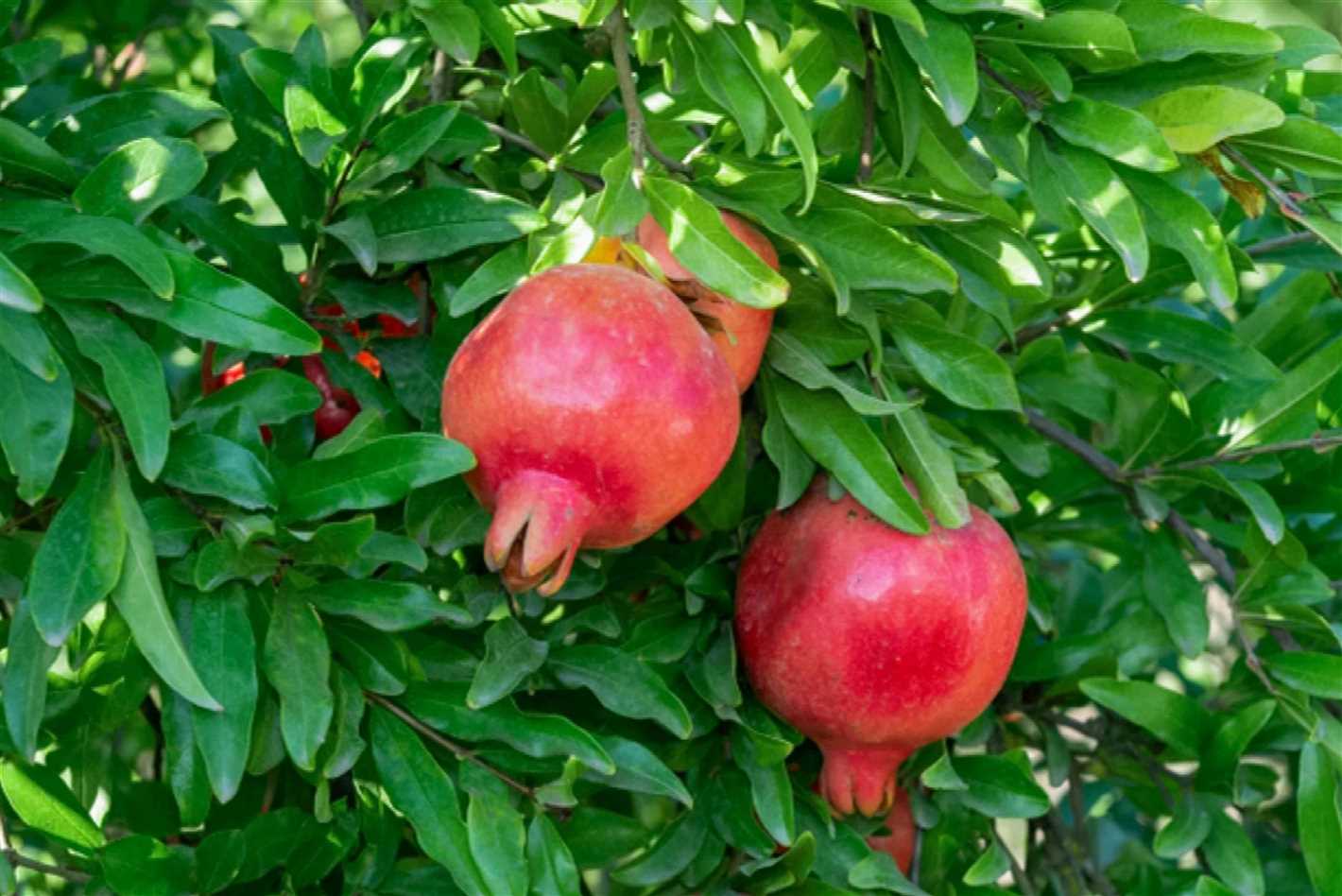
- Store pomegranates in a cool and well-ventilated area, such as a cellar or refrigerator.
- Place the pomegranates in a single layer to prevent them from getting crushed or spoiling.
- Do not wash the pomegranates until you are ready to use them, as moisture can lead to spoilage.
- Pomegranates can be stored for up to two months when properly refrigerated.
Tips for Handling Pomegranates
- Wear gloves when handling pomegranates to avoid staining your hands and clothes with their red juice.
- When cutting a pomegranate, make a shallow incision around the fruit’s circumference and gently twist it open. This will help prevent juice splatter.
- Use a spoon to separate the seeds (arils) from the white pith of the fruit. This will make it easier to enjoy the sweet and tangy seeds.
By following these guidelines, you can enjoy fresh and delicious pomegranates from your own homegrown tree for an extended period of time.
Troubleshooting Common Pomegranate Problems
1. Lack of Fruit Production
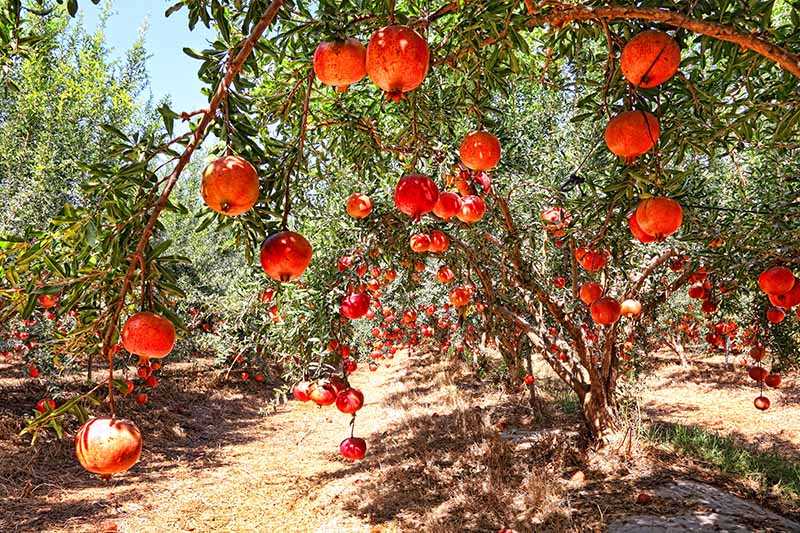
If your pomegranate tree is not producing fruit, there could be several reasons:
- Age: Pomegranate trees typically take 2-3 years to start producing fruit. Patience is key.
- Pollination: Pomegranate trees need cross-pollination to bear fruit. If there are no other trees nearby, consider planting a compatible variety.
- Fertilizer: Lack of proper fertilization, especially nitrogen, can inhibit fruit production. Ensure your tree receives balanced nutrition.
- Watering: Over or under-watering can impact fruit production. Aim for consistent watering, allowing the soil to dry between waterings.
2. Pest Infestation
Common pests that can harm pomegranate trees include aphids, whiteflies, and fruit flies. Here’s what you can do:
- Pruning: Regularly prune your tree to remove infested branches and promote airflow.
- Natural Predators: Encourage the presence of beneficial insects like ladybugs and lacewings, which feed on pests.
- Organic Sprays: Use organic insecticidal sprays to control severe infestations.
3. Diseases
Pomegranate trees can be susceptible to various diseases, including fungal infections and bacterial blight. Take these measures:
- Sanitation: Remove infected leaves, fruits, and branches to prevent the spread of diseases.
- Fungicides: Apply appropriate fungicides to control fungal infections.
- Preventive Measures: Maintain proper tree spacing, ensure good airflow, and avoid overwatering to minimize disease risk.
4. Yellowing Leaves
If your pomegranate tree’s leaves are turning yellow, it may indicate:
- Nutritional Deficiency: Check if your tree is lacking in nitrogen, iron, or other essential nutrients. Adjust the fertilization accordingly.
- Overwatering: Excessive watering can lead to root rot, causing yellowing leaves. Ensure proper drainage and adjust watering practices.
- Pest Infestation: Some pests, like aphids or spider mites, can cause yellowing leaves. Inspect your tree for signs of infestation.
5. Splitting Fruit
Pomegranate fruits can split if there are sudden changes in moisture levels. Prevention methods include:
- Consistent Watering: Maintain a regular watering schedule to avoid fluctuations in soil moisture.
- Mulching: Apply a layer of organic mulch around the base of the tree to help retain moisture and provide insulation.
- Harvest Timing: Harvest fruits at the appropriate time to avoid overripening and splitting.
Q&A:
What is the best time to plant a pomegranate tree?
The best time to plant a pomegranate tree is in the spring, after the danger of frost has passed.
Can I grow a pomegranate tree indoors?
Yes, you can grow a pomegranate tree indoors, but make sure it gets plenty of sunlight and well-drained soil.
How often should I water my pomegranate tree?
You should water your pomegranate tree deeply once a week, especially during dry periods. Make sure the soil is moist, but not waterlogged.
What type of soil is best for growing pomegranate trees?
Pomegranate trees prefer well-drained soil with a pH level between 5.5 and 7.5. Loamy or sandy soil is ideal.
How long does it take for a pomegranate tree to bear fruit?
It can take anywhere from 2 to 5 years for a pomegranate tree to start bearing fruit, depending on the variety and growing conditions.
What are some common pests and diseases that affect pomegranate trees?
Some common pests and diseases that affect pomegranate trees include aphids, scale insects, fungal diseases like powdery mildew, and bacterial blight.
Video:
How To Grow & Prune A Pomegranate Tree | Complete Step By Step Guide







